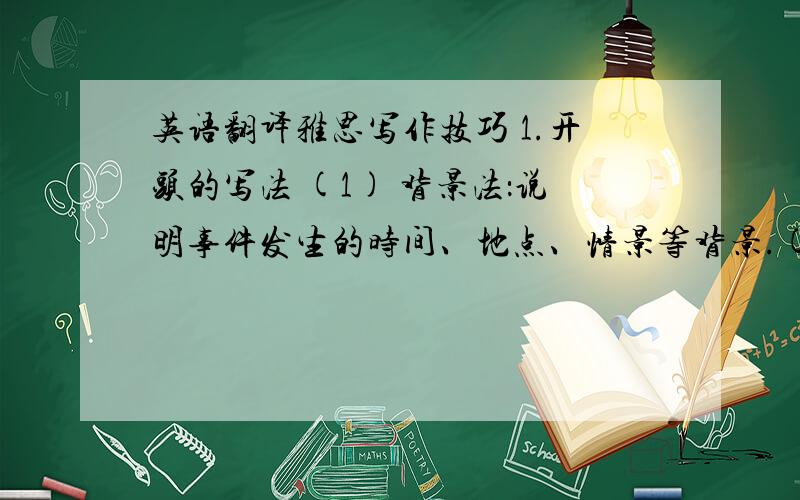英语翻译雅思写作技巧 1.开头的写法 (1) 背景法:说明事件发生的时间、地点、情景等背景.(2) 人物法:交代文章所要
来源:学生作业帮 编辑:大师作文网作业帮 分类:综合作业 时间:2024/09/20 11:49:47
英语翻译
雅思写作技巧 1.开头的写法 (1) 背景法:说明事件发生的时间、地点、情景等背景.(2) 人物法:交代文章所要描述的主要人物或有关人物.(3) 主题句法:提出一个观点或论据作为文章要阐明或论述的主题.(4) 用提问的方式来引出文章的内容,以引起读者的注意力.(5) 惊语法:用令人感到惊奇的句子开头,激起读者的兴趣.(6) 故事法:以讲故事的形式作为文章的开头,在此基础上展开文章.多用于记叙文,也可用于议论文.(7) 数据法:引用已经被证实的数字来引起话题.(8) 引语法:引用名人名言或常见习语、谚语等作为文章的开头.(9) 定义法:常见于对标题下定义,然后通过举例、逻辑推理等方法加以详细说明.(10)夸张法:以一个绝对不可能发生的为前提,吸引读者 (11)侧面转折描写:从另一个方面来烘托文章主题,引出下文.(12)设置悬念:激起读者的兴趣,文章格调升华.2.正文的写法 (1) 演绎法:从一般到个别.把带普遍性和概括性的句子放在段首,段落中其他的句子就是对主题句的具体化,是对主题句的具体说明.(2) 归纳法:从特殊到一般.具体、个别的事例出发,总结出一般的规律.3.结尾的写法 (1) 简要评价或作结论:文章的最后几句概括全文内容,并进一步肯定文章的中心思想或作者的观点.(2) 首尾照应句:回到文章的中心思想或主题句上,达到再次肯定或强调的效果.(3) 用反问句结尾:虽然形式是疑问句,但意义是肯定的,具有很明显的强调作用,能引起读者的思考.(4) 提出展望或希望:对未来提出展望或希望,号召读者为此而行动.(5) 引用名人名言、谚语、常用习语结尾.
不要用翻译器翻译的啊
雅思写作技巧 1.开头的写法 (1) 背景法:说明事件发生的时间、地点、情景等背景.(2) 人物法:交代文章所要描述的主要人物或有关人物.(3) 主题句法:提出一个观点或论据作为文章要阐明或论述的主题.(4) 用提问的方式来引出文章的内容,以引起读者的注意力.(5) 惊语法:用令人感到惊奇的句子开头,激起读者的兴趣.(6) 故事法:以讲故事的形式作为文章的开头,在此基础上展开文章.多用于记叙文,也可用于议论文.(7) 数据法:引用已经被证实的数字来引起话题.(8) 引语法:引用名人名言或常见习语、谚语等作为文章的开头.(9) 定义法:常见于对标题下定义,然后通过举例、逻辑推理等方法加以详细说明.(10)夸张法:以一个绝对不可能发生的为前提,吸引读者 (11)侧面转折描写:从另一个方面来烘托文章主题,引出下文.(12)设置悬念:激起读者的兴趣,文章格调升华.2.正文的写法 (1) 演绎法:从一般到个别.把带普遍性和概括性的句子放在段首,段落中其他的句子就是对主题句的具体化,是对主题句的具体说明.(2) 归纳法:从特殊到一般.具体、个别的事例出发,总结出一般的规律.3.结尾的写法 (1) 简要评价或作结论:文章的最后几句概括全文内容,并进一步肯定文章的中心思想或作者的观点.(2) 首尾照应句:回到文章的中心思想或主题句上,达到再次肯定或强调的效果.(3) 用反问句结尾:虽然形式是疑问句,但意义是肯定的,具有很明显的强调作用,能引起读者的思考.(4) 提出展望或希望:对未来提出展望或希望,号召读者为此而行动.(5) 引用名人名言、谚语、常用习语结尾.
不要用翻译器翻译的啊

1 at the beginning of the writing skills of IELTS Writing (1) background: that the time of the incident, location, and situational context. Figure (2): the main character in the replacement method to describe the characters or. Topic sentence: (3) put forward an idea or argument as to clarify or discourse topic. (4) problem: with the form of questions to elicit the contents of the article, to arouse the reader's attention. (5) was used to feel surprise Grammar: at the beginning of the sentence, arouse the reader's interest. (6) the story: the form of storytelling as the beginning of the article, the article on the basis. Used for narrative, can also be used for argumentative. Method: (7) data references have been confirmed to cause topic numbers. (8) the grammar: reference famous quotes or common idioms, proverbs as the beginning of the article. (9) definition: common in for the subject definition, a detailed description and examples, logical reasoning. Hyperbole: (10) to an absolute impossible as the premise, to attract readers (11) side turning Description: to express the theme from another aspect, leads to the following. (12) set up the suspense: arouse the reader's interest, the article style sublimation. 2 text writing (1) deduction: from the general to the individual. The universal and general sentence in the first paragraph, other sentence is the topic sentence of the concrete, specific description of the topic sentence. (2) induction: from the general to the special. In particular, individual examples, summed up the general rules. 3 at the end of the writing (1) a brief evaluation and conclusion: the last few words full text, and further confirmed the central idea or author's point of view. (2) both anaphoric sentence: back to the central idea of the article or topic sentence, be or emphasize effect. (3) end with a rhetorical question: Although the form of a question, but the meaning is in the affirmative, is clearly emphasize the role, can cause the reader's thinking. (4) put forward the prospects for the future or hope: put forward or hope, which called on readers to action. (5) cited the famous quotes, proverbs, idioms.
英语翻译雅思写作技巧 1.开头的写法 (1) 背景法:说明事件发生的时间、地点、情景等背景.(2) 人物法:交代文章所要
谢太傅家人咏雪的背景,极精炼地交代了什么?时间“ ”、地点“ ”、人物“ ”事件“ ”等要素,
129事件的发生背景?
法布尔的写作背景
中国历史上发生的重大事件:时间+地点(人物)+事件
要一些作文的开头时间地点,描写景物额,倒叙,对比衬托,抒情,交代写作动机.分别列举一个,
巴金文章的写作手法,写作背景!
的作者是?写作背景,写作时间?
石壕吏 诗的前四句交代了故事发生的时间和地点人物是什么
环境描写片段200字 要求:1交代时间、气候、背景2烘托人物心情3渲染气氛4表现文章中心5为下文作铺垫、伏笔
中,文章开头为什么要交代人物的贯藉,
雅思大作文开头段的写法当中 背景怎么写?